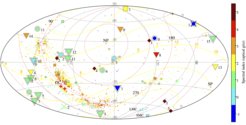Looking for new neutron stars in our neighbourhood with Gaia
Study discovers new neutron star candidates in catalogues and provides methods and tools to find more
Neutron stars are compact remnants of supernova explosions. Only a small fraction of the vast population of these objects in our Milky Way has been discovered so far, and at distances beyond 125 parsecs. Now, a researcher at the Max Planck Institute for Gravitational Physics (Albert Einstein Institute) in Hannover has developed and described new methods to identify nearby neutron stars, using broad-optical data from the Gaia astrometric space mission. The investigation is complemented with catalogues covering the entire electromagnetic spectrum (gamma rays, X-rays, ultraviolet, broad-optical, infrared, and radio waves). The novel search finds sources that may hold neutron stars at distances between about 60 and 120 parsecs from Earth. For each candidate, the study provides information to enable further studies. For example, searching for continuous gravitational waves from them, which might allow to examine the interior structure of these fascinating objects.
Paper abstract
Neutron stars are identified as pulsars, X-ray binary components, central objects of supernovae remnants, or isolated thermally emitting sources, and at distances beyond 120 pc. A population extrapolation suggests 103 objects within that boundary. Potentially, neutron stars could continuously emit gravitational waves at sensitivity reach of present instrumentation. As part of our Search for the Nearest Neutron Stars “Five Seasons” project, we search for nearby resolved neutron stars. Based on expected fluxes and magnitudes of thermally cooling neutron stars and pulsars, we selected sources in Gaia DR3. The sources have G-band absolute magnitudes MG>16 mag, parallax signal-to-noise ratios greater than two, and colours GBP–G<0.78 and G–GRP<0.91 mag for power-law emitters of flux Fν ∝ ν–ɑν with spectral indices ɑν< 3. The photometric region overlaps with that of white dwarfs, in confluence with most known pulsars in binaries having white dwarf companions. We looked for counterparts in gamma-ray, X-ray, ultraviolet, radio, optical, and infrared catalogues. We find about two X-ray-, 15 ultraviolet-, one radio probable counterparts, and at least four sources with power-law profiles at the ultraviolet–optical(–infrared). Because the sources have G≳20 mag, we rely on Gaia DR3 single-source parameters. We identify possible binaries based on photo- astrometric parameters, visual companions, and flux excesses. Some emission components suggest small thermal radiuses. Source types, neutron star content, and properties require further inquiry.













